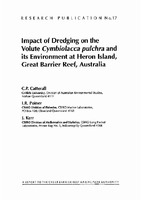Please use this identifier to cite or link to this item:
https://hdl.handle.net/11017/298

| Title: | Impact of dredging on the volute Cymbiolacca pulchra and its environment at Heron Island, Great Barrier Reef, Australia |
| Authors: | Catterall, C.P. Poiner, I. R. Kerr, J. |
| Keywords: | Dredging;Environmental aspects;Volutidae |
| metadata.dc.subject.asfa: | Dredging Environmental monitoring Density (population) |
| APAIS Subject: | Biology Environmental management Environmental impact |
| metadata.dc.subject.category: | Coastal development |
| Year of publication: | 1992 |
| Publisher: | Great Barrier Reef Marine Park Authority |
| Series/Report no.: | Research publication series no. 17 Research publication |
| Abstract: | The impact of dredging operations on the volute Gastropod (Cymbiolacca pulchra) population of a coral reef atoll (Heron Island, Great Barrier Reef, Australia) was investigated using data from annual surveys of the population and its environment Comparisons were made of pre-dredging (1984 to 1986), during-dredging (1987) and post-dredging (1988 and 1989) summer densities and size distributions of volutes at eight locations on the reef. There was significant variation among the sites in the pre-dredging years with volutes restricted to four sites characterised by a combination ofre1ative1y low bommie cover « 2%) and high sand cover (> 75%). All four sites were influenced by the dredge plume during dredging operations (September to November 1987 and February 1988). Volute densities declined significantly during dredging (1987) compared to the pre-dredging years. In the following year (1988) the difference was highly significant with zero densities recorded. By 1989 there had been a recovery with no significant difference in the overall density of volutes although the density of small volutes was greater and larger volutes smaller compared to pre-dredging densities. From June 1985 to May 1986 monthly counts were made at all sites to examine seasonal patterns of recruitment Recruitment into the population occurred over much of the year, though it tended to be higher in the autumn months (March to May), presumably following summer breeding. We suggest that the declines in volute densities were probably due to a failure of recruitment during dredging coupled with a loss of large volutes which may have resulted from natural mortality, emigration, or dredging. The recovery probably followed immigration of large volutes from less affected areas. The environmental factors of percent cover of sand, rock, rubble, coral, bommies and macroalgae were also monitored and there were significant changes in the cover of algae, coral, sand and rubble. These changes are interpreted as covariates rather than causes of observed changes in volute densities. Post-dredging increases in the cover of algae persisted beyond the termination of this study. |
| URI: | https://hdl.handle.net/11017/298 |
| ISBN: | O642174008 |
| Type of document: | Report |
| Appears in Collections: | Management |
Files in This Item:
| File | Description | Size | Format | |
|---|---|---|---|---|
| Impact-of-dredging-on-volute-Cymbiolacca-pullchra.pdf | PDF version | 27.04 MB | Adobe PDF |  View/Open |
Items in ELibrary are protected by copyright, with all rights reserved, unless otherwise indicated.
